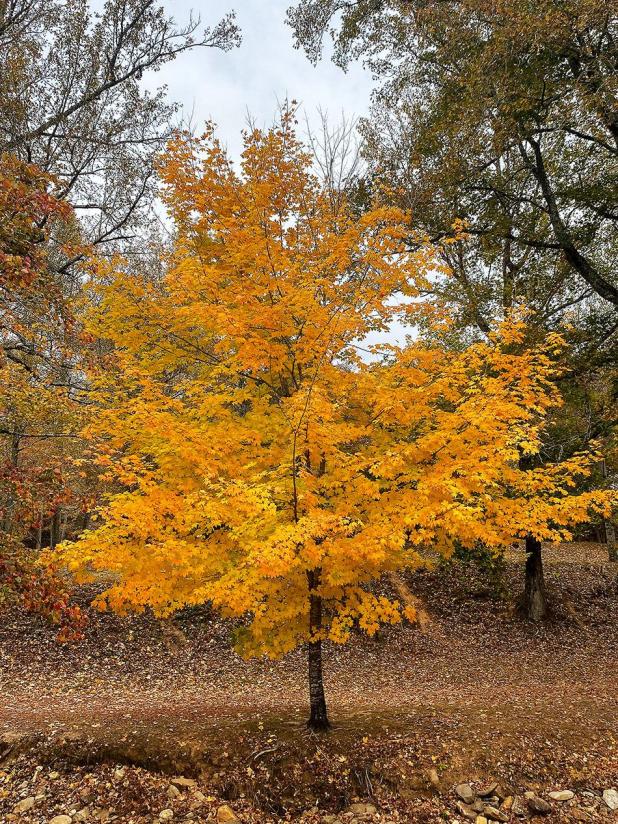
Trees stop the production of green pigment chlorophyll, revealing carotenoid pigments that give way to yellow. Anthocyanin pigments are responsible for purple and maroon colors of leaves in fall. Fallen leaves can be raked and used as mulch in landscape beds and gardens or composted.
—LSU AgCenter/Heather Kirk-Ballard
Get It Growing: The science of fall foliage
Shorter, cooler days bring brilliant foliage color changes for many trees and shrubs in fall. This time of year can be very beautiful as green leaves give way to brilliant colors of gold, orange, maroon, red and yellow.
What is the reason for this color change? Trees are preparing for winter, and the color change is a byproduct of this process.
Broadleaf hardwood trees do this by losing their leaves so they won’t freeze when temperatures drop. The leaves of deciduous broadleaf trees are tender and susceptible to damage because they are thin and not protected by waxy coverings like evergreen trees. The fluid in the cells of the leaves freezes and must be sealed off and dropped in order to survive winter temperatures.
Evergreens such as pines and cedars are able to survive winter because they have needles covered with a heavy wax coating and they produce fluids that resist freezing. Thus, the foliage of evergreens can safely withstand all but the more severe of winter conditions, although they do shed some of their needles.
Autumn color can vary from year to year depending on the weather leading up to the falling of the leaves. The main influences are temperature and moisture.
Late-spring and severe summer droughts as well as extended heat can delay the onset of and decrease the intensity of the fall color change. However, a warm, wet spring and good summer weather followed by warm, sunny fall days with cool nights and shorter days signal winter is coming. This is when deciduous trees begin their transformation.
Longer, cooler nights as we move toward winter tell the tree to stop making food. This stops the production of the pigment chlorophyll that gives leaves their green color. When this happens, other pigments such as carotenoids now become visible, revealing the beautiful colors of orange and yellow.
Plants produce their own food through the process of photosynthesis by harnessing the energy of the sun. They make food from carbon dioxide removed from the air through the use of chlorophyll to create sugar and starches.
Cooler nights signal to the plants to gradually close the veins in the leaves, and the sugars produced during the day become trapped and cannot move out. This leads to the production of plant pigments such as anthocyanins, which yield beautiful maroons, purples and reds.
The veins that carry fluids into and out of the leaves gradually close off as a layer of cells forms at the base of each leaf. Once the leaves are sealed off, they are ready to fall when a heavy rain or wind removes them from the tree.
Tree species can be recognized by their distinct colors in winter. Chinese pastiche turns to brilliant reds and yellows, beeches turn light tan or gold, and oaks typically turn red, russet and brown. Poplars turn yellow, hickories golden bronze, black tupelo turns crimson and maples can be red or orange-red and yellow. Most other trees’ leaves simply shrivel up and turn brown.
Leave the leaves. Needles and leaves that fall are not wasted. They decompose and replenish the soil with nutrients and make up part of the spongy humus layer of the forest floor that absorbs and holds rainfall. Fallen leaves also become food for numerous soil organisms vital to the forest ecosystem.
By leaving fallen leaves on the ground, you provide materials for earthworms to break down and shelter for insects such as butterflies and moths that overwinter in leaf litter, providing a winter food source for many bird species.
Chop or shred leaves to make it easier for worms and beneficial microorganisms such as fungi and bacteria to break down the leaves. Leaves can be composted first to make leaf mold, or you can work the leaf mold into the top several inches of the soil in autumn. In addition, chopped leaves can be used as a winter mulch on top of garden beds to help retain moisture, reduce weeds and insulate roots from cold temperatures.
Autumn colors can be observed anywhere trees grow. There are many state and federal parks with beautiful scenic byways to observe the brilliant colors against dark, broadleaf evergreens and conifers. Take it easy and enjoy the changing of the season and the natural gift of color this fall.
